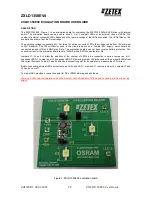
Theory of Operation
9
MT-3 FM Transmitter Mainboard Instruction Manual
IM20-MT3TXMN
The actual current and start-up time depend
on the oscillator source and amplifier module.
The current and start-up times given below
are representative values intended only as
guidelines. For further information, refer to the
appropriate modular instruction manuals for
specific oscillator and amplifier types.
Standby mode Selection table
mode #
Standby Current
turn-on time
1a
14 ma
150 mS
1b
21 ma
10 mS
1c
14 ma
10 mS
2a
166 ma
150 mS
2b
173 ma
10 mS
2c
167 ma
10 mS
3
29 ma
10 mS
4
181 ma
10 mS
NOTE
: Standby Current is the total current
drawn by the synthesizer and FM Audio
Processor from the +9.5 VDC supply.
fm audio Processor total Current Consumption
Compression
Configuration
audio Processor
Current draw
Keyed / unkeyed
Compression enabled (Ju36 X)
15 ma / 0.45 ma
Compression and microphone
disabled (Ju36 open)
9.2 ma / 0.45 ma
Compression enabled (Ju36 y)
15 ma / 9.2 ma
audio Circuits
The FM Audio Processor performs audio signal
conditioning (e.g., limiting, filtering and pre-
emphasis). The transmitter mainboard routes
the audio lines from the backplane connector to
the audio processor and then to the synthesizer.
The audio lines routed to the audio processor
are two subtone inputs (backplane pins B22
and Z24), a direct modulation input (pin Z28), a
squelched / flat audio input (pin Z20), a 600 Ω
balanced input (pins B18 and Z18), and an audio
control line (pin Z22). The audio processor’s
balanced input pins are isolated from pins B18
and Z18 by a transformer (T1).
Two audio outputs from the FM Audio Processor
are routed to the synthesizer modules.
microphone audio
Normally the microphone audio is sent from
the attached transmitter, however the MIC IN
and MIC OUT lines can be configured on the
transmitter mainboard such that the microphone
audio modulates a different transmitter. The
configuration of the MIC IN (pin Z4) and MIC
OUT (pin B4) lines on the MT-3 FM Transmitter
Mainboard are controlled by jumpers J16
and J17 respectively. Jumper J16 selects the
audio source for the FM Audio Processor’s
microphone input. Jumper J17 is used to enable
or disable the MIC OUT line. Normally the
transmitter’s microphone is selected (J16 in the
X position) and the MIC OUT line is enabled
(J17 is installed).
received audio
Pin B20 is the audio input from the transmitter’s
corresponding receiver. The default setting for
this line is to have it AC coupled (Jumper J9 is
out) and directly connected to the front panel
board RX AUDIO line.
Channel Selection
Synthesized transmitter
Seven backplane connections are used to
communicate with the synthesizer unit. Pins
D28, D30 and D32 are used (in house) to
program the synthesizer. Channel select lines
CSEL 0 (least significant bit) through CSEL 3
(most significant bit), which are available at
pins D20, D22, D24 and D26, are used once
the synthesizer is programmed to select one of
16 channels. If the channel select lines are all
low (Channel 1) the channel for the synthesizer
is read from switches FSW1 (most significant),
FSW2, FSW3 and FSW4 (least significant);
otherwise one of 15 pre-programmed
frequencies is selected. Refer to the channel
designation tables (manual IM20-VT3H040CT)
to set the operating frequency.














































